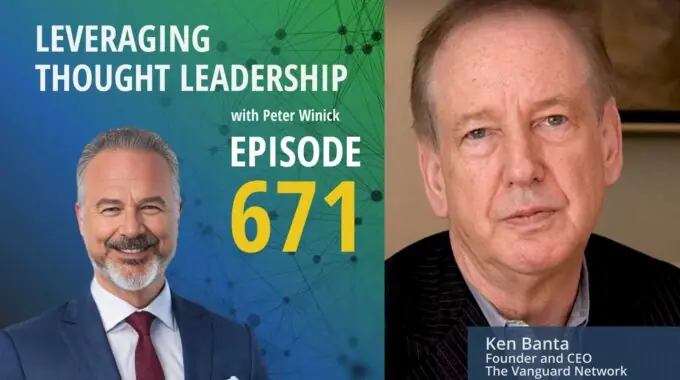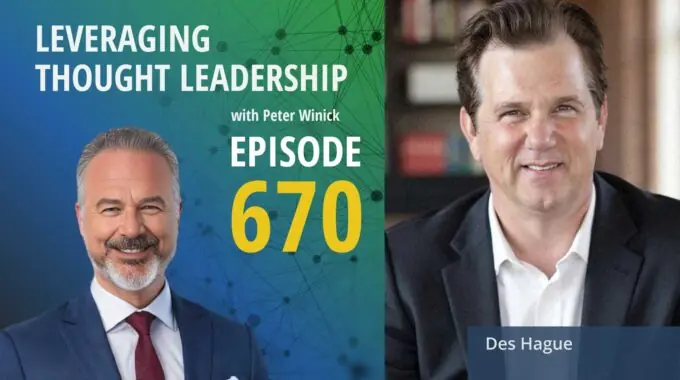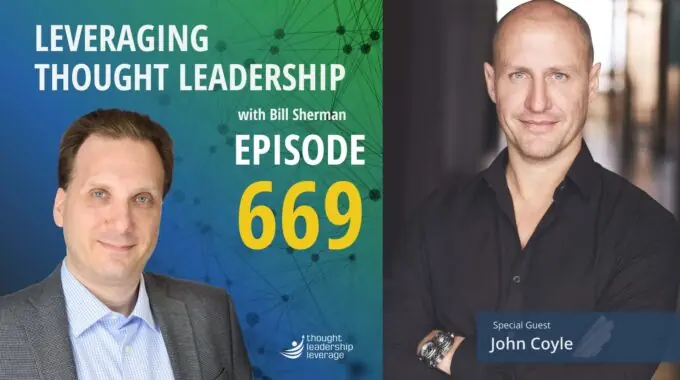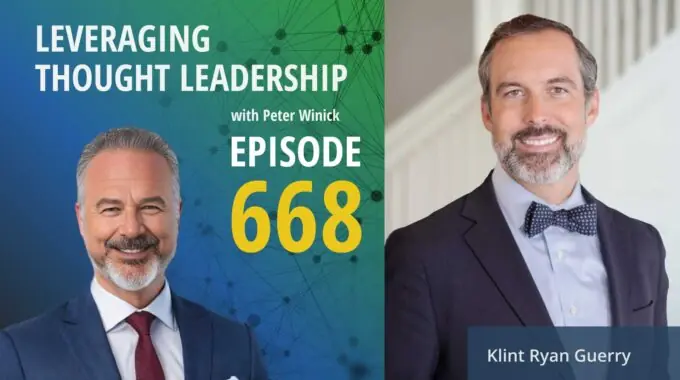Turning Conversations into Influence This episode highlights how peer-to-peer networks drive candid dialogue, spark fresh…
The Business Side of Thought Leadership | Stephen M. R. Covey
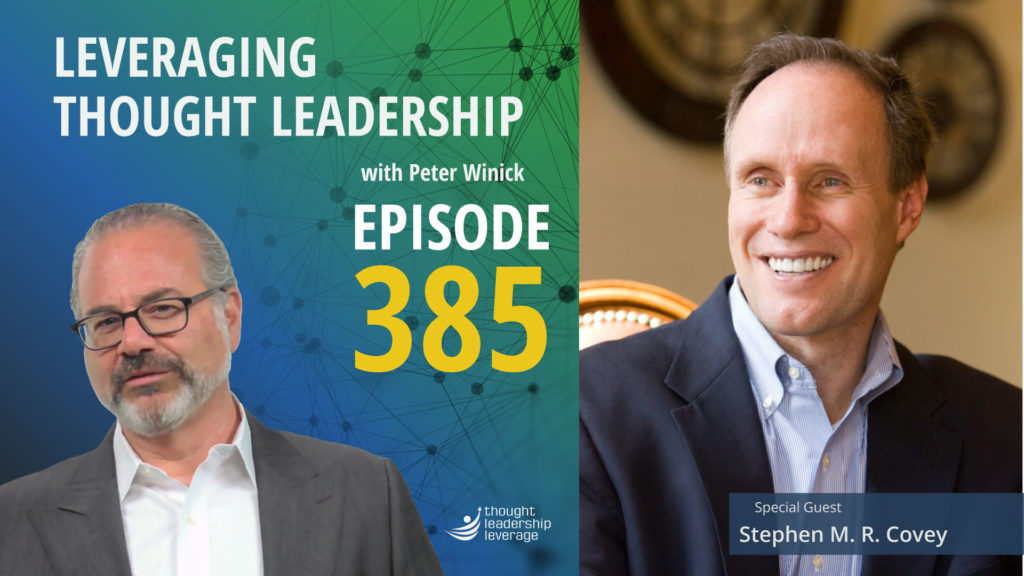
Learning the back-of-the-house operations before taking the lead.
An interview with Stephen M. R. Covey about building a healthy thought leadership company, and the lessons he learned along the way.
Many thought leaders start with speaking, consulting, and creating content. They love their insights, and want to share them – but they don’t always stop and think about their business model. What products will you offer? How will you market them? What kind of ROI, KPI and other metrics will you use?
What would it be like to start on the business side, before stepping out with your thought leadership?
We are thrilled to have Stephen M. R. Covey join us again on our podcast. Stephen is the co-founder of Covey Link and Franklin Covey, the bestselling author of The Speed of Trust, and a global authority on trust, leadership, and culture. Stephens’s incredible career can be divided into two acts: first, as a leader on the business side of operations, he was charged with figuring out how to scale and leverage the work of his father Stephen R Covey; then, he stepped forward to share his own thought leadership alongside the gold standard his company achieves.
Stephen explains his realization that thought leadership practitioners don’t have to choose between impact and income. By aligning the two, and focusing on the audience that would benefit most from your insights, you can have great ideas and make money
Over the years, Stephen has watched the industry move from analog to digital and has continued to be at the forefront of change. We discuss the forward-thinking ideas he had during the analog years (creation of certifications and train-the-trainer), and talk about the challenges and successes involved with staying at the top in this digital world. Stephen also shares his reasons to believe that intellectual property will always be the underlying engine of any platform or medium.
We wrap our conversation by discussing Stephen’s new book, Trust and Inspire. Stephen enlightens us about how little leadership has changed from the industrial age. While we have polished and refined the system of “Command and Control,” today’s environment requires more. Stephen gives us a rundown of his new system, what “Trust and Inspire” looks like, and why it’s more complete and robust way of leading is more relevant in today’s workplace.
Three Key Takeaways:
- The primary goal of thought leadership should always be the mission. Balance the scales between margin and reach, and don’t lose sight of the mission.
- Even if you believe that your insights are for everyone, don’t overreach. Focus on your most integral audience, and create a profitable core before reaching out to a broader field.
- When the market wants something – give it to them!
If you need a strategy to bring your thought leadership to market, Thought Leadership Leverage can assist you! Contact us for more information. In addition, we can help you implement marketing, research, and sales. Let us help you so you can devote yourself to what you do best.
Transcript
Peter Winick And welcome, welcome, welcome, this is Peter Winick, I’m the founder and CEO of Thought Leadership Leverage, and you’re joining us on the podcast today, which is Leveraging Thought Leadership now. Normally I do an introduction, but today’s guest, I’ll do a small introduction. He doesn’t need one. So his name is Stephen MR. Covey. He and I have known each other for a long, long time. If you don’t know who he is, he is the co-founder of Covey Lincoln Franklin Covey. He is the New York Times number one Wall Street Journal best selling author of The Speed of Trust. He’s got a new book coming out called Trust and Inspire, which I’m sure will go to the stratosphere as well. He’s the former CEO of Covey Leadership. And what else could I say about Stephen other than an all around great guy that I’m really excited to talk to today?
Stephen M.R. Covey So welcome, Steven, and thank you for joining us.
Stephen M.R. Covey Hi, Peter. Great to be with you again. I always enjoy it.
Peter Winick So what I one of the things I love not only about your work, but you’re a rare bird from the perspective of you started in what I would call back of the house. So it took me a million years of just being a dork, reading zillions and zillions of books to ever have the I don’t know, whatever the epiphany to go, “I wonder how any of these folks make a living like this?” Because why would anyone think about this other than someone that’s like obsessed with it, which is now what I do all day, every day and have the greatest job in the world? But like you started on the on the business side of leadership. So tell us about that because you can probably teach us a few things there, I would hope.
Stephen M.R. Covey Yeah. Yeah. No, I’ve been I’ve had two acts in. The first act was on the business side. The second act is what I’m doing now on the thought leadership side. But they overlap, obviously. And so, yeah, when I was president and CEO of my father’s firm, Covey Leadership Center, you know, he had great ideas, as you know, with seven habits of highly effective people. One of the.
Peter Winick Doesn’t get better than that, right?
Stephen M.R. Covey Yeah, it doesn’t get any better than that. And so I was kind of charged with trying to figure out how to really scale this, how to really leverage this, the very nature of this podcast, you know, how do we leverage this thinking this idea in a way that could really impact a lot of people? Our primary goal, Peter, always was mission. But I also learned that if there’s no margin, there’s no mission. And so my job was to try to build a business model that would enable us to both scale the business impact and reach more people, but also be something that could be profitable so that we could fund that, fund the business and we could grow the business. And we could have some profit in the business because without that margin, we wouldn’t have nearly as robust a mission as well.
Peter Winick Yeah. So I think that often folks pick a side.
Stephen M.R. Covey Yeah.
Peter Winick Well, I’m focused on impact. I’m focused on income and I’m like, No, that’s the wrong answer, right? Because impact without the income is non- isn’t self-sustaining, right? And then income without the impact. It’s sort of like, Well, why get out of bed? I guess you could do that. Yeah. But sort of what’s the point there intellectually and just satisfaction wise?
Stephen M.R. Covey Yeah, I really think is a third alternative that is not either or, it can be and. And I think the best approaches are and because, like you say, you could just have great ideas where your whole goal is to make money. But you know, that’s without contribution to it, and it’s not nearly as meaningful as an impact. And the flip side is true you could have, you know, a great mission. But if you don’t have an ability to have a business from that, the mission is always going to be struggling to get out. And we kind of early on, we kind of were in that latter camp. We had all these great ideas and we were trying to take it to everybody in no sequence. Just get it out there.
Peter Winick So, yeah, yeah. So, the take it to everybody problem. I see this all the time. So, one of my parts of my, I don’t know, intake or whatever when I’m talking to a potential client is described to me who you think could benefit most from your work and why? Right? And that’s not a difficult question, but I think a lot of folks are so entrenched in their stuff that they don’t put their business hats on. Well, everyone could benefit from my work, right? And my answer to that is, well, that’s great. But we don’t have the marketing budget of Coca-Cola that can market to everybody or Procter and Gamble. So, we need to start making some decisions here who would benefit the most. And, you know, a piece of content, theoretically, they’re few and far between seven habits being one of them that theoretically could be anybody can benefit from. But even when that’s the case, you have to figure out where is the market going to reward it the most so that it can have a bit of a flywheel? Is it on the sales side of the house, the marketing side of the House, newly minted leaders? And the more you get focused on that, the easier it is right? And you made some mistakes that you’ve done many things well along the way as well.
Stephen M.R. Covey Absolutely. And you know, it’s this is the curse of missionary overreach, which is because it can apply everywhere because you are mission driven. It’s very easy to say, let’s take it everywhere. And the problem with that is that you’ll ultimately run out of margin to fund the mission. And we began to have that issue. And so, we had to learn that, yes, we wanted to take seven habits everywhere. But by learning to take it first to businesses that had budgets and funding for it and doing well with them, that enabled us to go to some of these other markets if we wanted to go to ultimately the education, be it government and even communities. And early on, we were trying to do everything at once. And as a result, their business model didn’t fully work and were always running out of cash, always borrowing money and trying to, you know, but I had this wonderful mission. And so, I tried when I came in, I made my whole goal was to not make it a dichotomy. They did not say, Hey, no, no more mission anymore. We’re going to we’re going to be a business that wouldn’t have gone over well in the culture or with my dad. And so instead, I said, Look, we’re a mission driven business, but we need to be a business in order to have credibility and to be sustainable. But we’re not an ordinary business that’s just trying to make money. Now we’re a mission driven business.
Peter Winick And that concept – 20 some odd years ago – was a radical concept. Now it seems like with corporate social responsibility issue to whatever that every company is, or at least. Tries to project to the market that they are but having that at your essence helps you make some decisions around what’s going to work for the culture and self-sustainable. I want to go down a different path for a moment before we get to the content of given that you and I have a couple of gray hairs here. You’ve also seen the thought leadership world moved from a largely analog by a book that lands with a thud. Bring our consultants in to do workshops or keynotes or whatever all analog things deliverables, and they’re all great deliverables. They spoke to us today and then the power of digital so that it gives you more ways to deliver the message and the content and to monetize it to more people. And it seems to be moving so quickly. And you know, it wasn’t all that long ago that a TED talk was the short form content of 18 minutes, which is now war and peace in terms of content length but concrete. If you could a little bit about sort of the balance or the transition, if you will, from analog to digital in many areas.
Stephen M.R. Covey Yeah, now this this shift is enormous, it’s taking place and. And here’s the good news the good news is still the power of ideas of intellectual property that gets kind of codified is still the underlying engine.
Peter Winick Sure, absolutely.
Stephen M.R. Covey Because there – our mediums, and our ways of of spreading it, is shifting and changing in extraordinary ways that can have a greater impact and also can even increase profitability as well because of the fact that now suddenly there’s possibilities and opportunities that maybe we didn’t have before under the old analog model. You know, going out and doing it yourself and this and that and even I will say this, even the old analog model, we were at the forefront at pushing the envelope on that, doing things like creating certification and let’s train the trainers and the trainer. That sounds commonplace today. At the time, it wasn’t. And it was seen as well. Why would you do that? Why would you do a certification of. Right? Yeah. Well, take away your presenting days, but you know, you can reach a lot more people and you can do a lot more work. And so even some of the analog, there’s some breakthrough thinking and you have a similar thing happening today that enables you to move into whole new arenas, including, for example, like subscriptions and this type of thing where you try to you can kind of codify you still, you still start with intellectual property, with ideas that are codified and branded and the like. But then you have now new ways of scaling it and of disseminating that and have and have also created new business models for it. Or certainly, for example, a prescription approach could be valuable in other approaches that you just didn’t have in the analog model.
Peter Winick When I think of in the digital dittrich today, because more choices give you more options to make good choices and bad choices, but getting really clear about who you’re serving and how you’re serving them helps you make decisions around the modalities, right? So even if you look at where I think the most confusion lies as in social media and I hear all the time, should I be on Tik Tok? Should I be on Instagram? Should I be on Clubhouse? And I’m like, Well, where are your clients and potential clients? Are the people you want to reach. Hang out. There’s nothing to do with you. Whether you like it or not, it’s not about you. Is that a place that is aligned to your brand, right? Or what else are they? What else are people talking about or doing there? Will it connect? Or is it just noise? Or is it the peer pressure while everybody else is doing? Right? And until you could sort of make the case business wise, I would say you don’t need to be the first kid on your block, on TikTok or Insta or whatever the market sort of will guide you where to go there?
Stephen M.R. Covey Absolutely. The market sets par. And you know, and it guides you and it helps you. But I think that that that step of really understanding markets and customers that the fundamental marketing.
Peter Winick Yeah, yep.
Stephen M.R. Covey And really, business step is the very first step. Understanding markets and customers and starting with needs and then the markets and customers. And then you figure out the channels and the modalities and the like. But too often, if you just jump right through the channels and the modalities and get the understanding markets and customers, then we’ll find ourselves again fragmented, trying to do too much across the board and our options than ever before.
Peter Winick If you’re enjoying this episode of Leveraging Thought Leadership, please make sure to subscribe. If you’d like to help spread the word about our podcast, please leave us a review and share it with your friends. We’re available on Apple podcast and on all major listening apps, as well as at Thought Leadership Leverage dot com forward slash podcasts.
Peter Winick And I – sometimes thought leaders are shocked, on both sides, good, bad and ugly, whatever that what they thought was the thing. Wow, this is my most brilliant piece of intellectual property. This idea is the holy grail. And in the markets is not so much, and there might be something else that you put out there that you’re like, Well, it’s okay, but it’s, you know, it’s not my best friend. For some reason that sticks to the mark. Yeah, and you could be stubborn and say, but my better idea is the one they should like. No. You know, sometimes people like what they like. And, you know, I wouldn’t have bet on [sic] was like, it comes out of nowhere, right? Like, it was always a filler on the play, you know, and it’s like, OK, people are into chaos and give more gal.
Stephen M.R. Covey Yeah, yeah. It’s a little bit of you know that proverb when that when the student is ready, the teacher appears. Exactly, exactly. And when the market is clamoring for something or responding, does that mean? Well, the great that’s relevant. It’s obviously connecting in that way. And when you do thought leadership works and rhymes, you’re trying to push instead of pull idea and allowing the poll to take place is really important. I think of a have a movie coming out, you know, you want you want the movie to be a artistic success, but also a commercial success. And then I like I’ve got the artistic success, but you’re lacking the commercial success occasionally as the other way around where you get this great commercial success. But you feel like that’s not my best art. I got better.
Peter Winick Yeah, right.
Stephen M.R. Covey And so it’s always this balancing act. But the market, you know, speaks, you know, in the long run, it’s a really good gauge and guide. And so those are just some of the insights and learnings. I’ll give you one last one. And again, I was on the front end of this. Even this is 35 years ago. Even the decision to say, let’s put the ideas in a book. I think I mentioned this another podcast and there really was internal debate at the old level center. Should we put seven habits in a book?
Peter Winick Yes, it’s all in there, right?
Stephen M.R. Covey Yeah. They just buy the book. They will never bring us yet. And that was a scarcity mindset. But it was also back then. It was it was a real debate. And then it became very clear. No, no, no. Of course, you do it and it will actually create more opportunity and reach more people because our mission was so clear that became a no brainer for us. But for a while, there was a little bit of rest, and we actually had an outside consultant that came in and advised us not to put it in a book. And, you know, imagine the impact we would have had nothing compared to what we have had. So, you know, all of this is shifting and changing, but there are some fundamental principles and understanding markets and customers creating and codifying ideas that are robust that are that are they represent the simplicity and the far side of complexity. You have to pay the price. You have to work through the complexity to come out with simplicity. That’s complexity. A much more powerful idea.
Peter Winick Complexity, it is easy, yeah, yeah,
Stephen M.R. Covey Yeah, and then and then and then finding the appropriate modalities to reach those customers with that idea. Not trying to do everything at once,
Peter Winick Yeah, I know, love it.
Stephen M.R. Covey Those principles are constant, even as modalities and channels change.
Peter Winick Last couple of minutes we have. I would be remiss if I didn’t talk about the book because I’d love to talk about the book. Coming on the heels of Speed of Trust. But I mean, that’s 10 years old. 15 years old
Stephen M.R. Covey It’s 15 years old now.
Peter Winick Yes. Well, almost the speed of trust is now a teenager. I can’t believe it. So I mean, the beauty of speed of trust was the trust hacks and the trust dividend. How do you take a concept of trust, and you took the speed because the preexisting nurture was the trust was a byproduct of time? Mary Jo, I need to know you for 30 years. Jeez, whatever. And then you talk about the tax, the dividend, which is a beautiful framing. It’s a great example of a solid IP because nobody likes taxes. Everybody likes dividends rates. So regardless of your party affiliation, taxes, that dividends are good. So that was the gist in Apple. Give me the gist of trust and inspire. Yeah.
Stephen M.R. Covey Well, the gist is simply this, Peter, that our world has changed all around us and we know what we see, our experience, that our world has changed. But our style of leadership has not near enough. It hasn’t kept pace with this new world of work with a diverse workforce with the need for collaboration, innovation, with disruptive technologies. All these changes, we’re still operating with a leadership style that’s fundamentally rooted in the old world. In the industrial age. I call it command and control, and what’s happened is we become better at it. We become more advanced, adept, more sophisticated what I call enlightened command and control. But our paradigm is still rooted in the old model, and I’ve seen in order to have, and this is a thought leadership idea in order to have a true break through. We need a break with a break with traditional thinking. We need a break with command and control, not just incrementally improve it, but break with it in. Is that mean? That’s different in kind. And that’s what I’m calling trust and inspire. In contrast to command and control, trust inspires the new way to lead in a new world. Trust inspires a way of thinking about people and about leadership that’s more complete, more robust, more relevant for our times, for our day. It’s not limited by the by the smaller thinking, the limited thinking. That’s part of a command-and-control paradigm of a fixed mindset versus mindset trust. Inspire is all about seeing the potential for greatness inside of people and unleashing it instead of trying to contain and control it. And so, it’s all about the kind of leadership that’s needed in a new world where we need to win in the workplace. I win in the work for talent, you know, attracting and retaining, engaging and inspiring the best people, but also winning in the marketplace by being able to collaborate and innovate to stay relevant in the changing world. And you can’t command and control your way to collaboration and innovation. You’ve got to do it.
Peter Winick Well, I think it’s a clearly the right message at the right time, right, considering so many things going on in the world, but it’s I don’t know what it was intended to be timely or the world just made timely, but I think it’s definitely a message at the right time because, yeah, with the days of command and control over and you know, COVID put the nail in the coffin from the perspective of, you know, management by walking around, well, if we’re working remotely from the way we work, where we everything is different. So why would that framework continue to be impactful and effective in a whole new universe? I love the concept there, so I wish you the best with the book.
Stephen M.R. Covey I’ll just add. I’ll add one more thing. We’re all kind of clear that command and control is no longer relevant, and yet we’re still operating in it for the most part. Yes, the more enlightened version of it, what we’re less clear on is what we’re moving toward. And so that’s what I’m trying to do here. I’m trying to name it. I’m trying to describe it. Like Socrates says, the beginning of wisdom is the definition of terms. I’m saying that this is what we’re moving from command and control. What are we moving toward? Trust and inspire is very aspirational is where it’s very much where the world is going. Inspirational leadership trustee bringing out just inspiring others. And the whole premise is everyone can inspire. Inspiring others is a learnable skill. It’s not just for the charismatic, and it’s a whole new way of thinking about leadership. And so, I’m trying to teach, by contrast, which is, I think, a great thought leadership approach. And I’m also trying to name where it is that we’re going in a way that is aspirational, but also it represents isn’t that what we want to be fired? We all want that. Others want it, too. And this is a new way to lead in a new world because it will help us build a great culture. So, we win that war for talent. And you can’t command and control your way to that. Help us collaborate and innovate and stay relevant in a changing world. And you can’t out of control your way to that. So, addressing Inspire is the new way to lead in a new world. That’s the big idea behind the book.
Peter Winick Love it. Love the big guy, thank you so much, I appreciate it. Thank you, Steve.
Stephen M.R. Covey Absolutely.
Peter Winick To learn more about Thought Leadership Leverage, please visit our web site at ThoughtLeadershipLeverage.com to reach me directly. Feel free to email me at Peter at ThoughtLeadershipLeverage.com and please subscribe to Leveraging Thought Leadership on iTunes or your favorite podcast app to get your weekly episode automatically.



